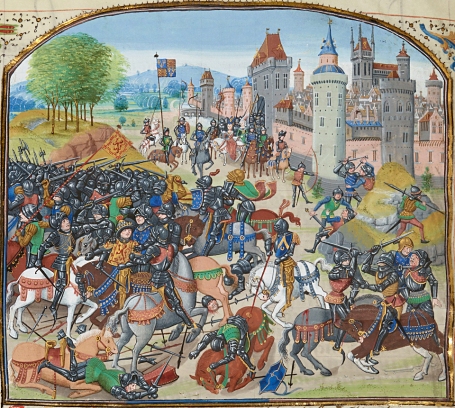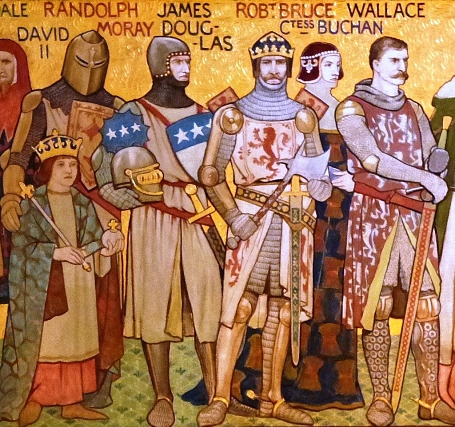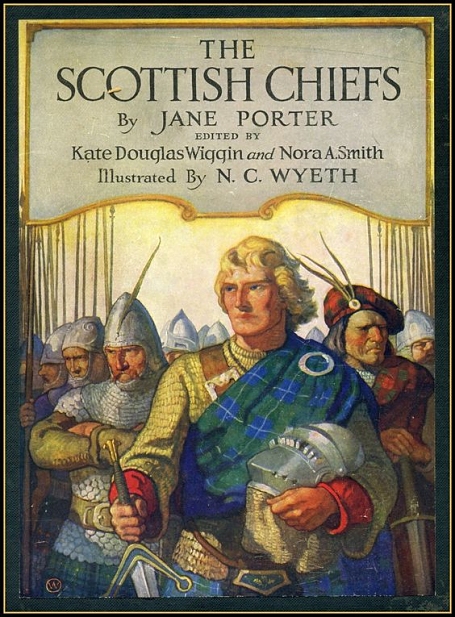The Life and Heroick Actions of the Renoun'd Sir William Wallace,
General and Governour of Scotland
by William Hamilton of Gilbertfield
Synopsis (Continued)
As November approaches, King Edward, pressed by Corspatrick, prepares to gather an army against Wallace. Forty thousand Scots assemble in response and Wallace, at Roslin-Moor, tells the nobles he will lead them into England. He takes twenty thousand men, sending the others back to work on the land.
With him as leaders go Earl Malcolm, Campbell of Locklow, Ramsay and Sir John the Graham, Adam Wallace, Robert Boyd, Lundie and Lauder, Auchinleck, Seatoun and Hay. On the way south Wallace rides with twenty men to Roxburgh and demands that Sir Ralph Gray give up the town or face being hung over the walls when the army returns. The same message is sent to Berwick, as the plundering army burns its way through Northumberland.
Durham town is burned; only churches and abbeys are spared as Wallace and his army continue their march on to York. Here they besiege the town for fifteen days, devastating the surrounding countryside until Edward sends notice that he will meet the Scots in battle in two weeks. On the second day Wallace's army removes to Northallerton and proclaims a peace until the battle commences.
Wallace learns that Sir Ralph Rymount, on the English side, has boasted of a surprise attack. Hay and Lundie are sent with three thousand men to quietly await Rymount's seven thousand. The Scots' ambush succeeds, killing three thousand English, including Sir Ralph. The army moves on to Miltoun where they find and avail themselves of provisions.
King Edward, based at Pumfret (Pontefract) Castle, is failing to persuade the English Parliament to consent to battle with Wallace. Word got out that they would agree only if Wallace proclaimed himself King, a treasonable act, and a trick that Wallace recognizes and avoids.
Some followers want Wallace to become King, others say Parliament should decide; Campbell suggests they crown Wallace for one day to put an end to the delay, but Wallace refuses. He suggests that to move Edward forward they should simply "put the story forward" that he's been crowned. Scots messengers are sent out with the story. The English, upon receiving this news, continue to debate, some wanting battle and some wanting to stay secure behind castle walls. In the end, they decide not to engage in battle with the Scots; all markets are banned in the hope Wallace's men will grow hungry and return to the north.
After forty days the Scots army sacks Northallerton town and devastates all the land within seven miles, sparing only women, children and the churches. They return to York to besiege and attack the town.
Dividing his army into four, Wallace surrounds the town. Himself with Lauder in the south, Earl Malcolm and Boyd at the west, Campbell and Sir John Ramsay at the north, and Sir John the Graham and Auchinleck at the east. Each quarter has an equal number of one thousand archers.
Within the walls seventeen thousand English attempt to give battle, but are forced inside. Fire and burning pitch is hurled over the walls causing havoc and destroying much of the defense. This tactic is repeated on the second day. On the third day, English Lords, Sir William Mortoun and Sir William Lees, lead an assault out of the town on Earl Malcolm's men, but to no avail. Wallace joins in and kills Mortoun and cuts the nose off the other.
Further attacks are launched on York the following day, until an English major within the walls calls out offering to pay ransom. Wallace replies that he wanted battle with Edward's army, as he'd been promised. With supplies becoming scarce, he accepts a bargain: he'll stop the attacks if the town displays a Scottish banner on the walls, pays a ransom and provisions Wallace's men. For twenty days Wallace and his men stay at York, then move on, destroying everything in their path - burning and tearing down buildings, destroying parks and feasting "like Princes" on deer.
Landowners call upon King Edward to act, or they will agree to terms with Wallace - they will take protection from him and accept his peace. Much of Edward's army has deserted; there is nothing he can do to stop Wallace's men.
Wallace's army, growing tired of poor supplies, want to return to Scotland. Wallace consults with Jop, who knows the countryside. Jop advises Wallace that good supplies, wine and food, can be found in Richmond shire, so there the nine thousand Scots march.
At Ramswatch, commanded by Lord Fechew (Fitzhugh) - King Edward's nephew - five hundred Englishmen assemble to protect the place and call to the Scots to fight. In response, Wallace has his men gather huge quantities of dry timber from nearby and set it around the tower with barrels of pitch to further the inferno. Women and children fall to their knees, crying out for mercy and are spared, but the flames and smoke kill the men inside, including Fechew who leaps from the walls into the fire.
His severed head is given to his widow and Wallace orders her to London to tell the King that unless he comes north to fight that in a month he will be at London's gates.
When the widow presents his nephew's head to him, Edward stands "Weeping and wailing for his tender Blood." The King's counselors fear losing England to Wallace; Woodstock suggests they purchase peace from Wallace and eventually Edward agrees, but no one is willing to take the message because he so often broke his word to Wallace. The Queen, seeing all refuse, suggests she carry the message, as Wallace may treat with a woman - someone who does not "mind him of War." This plan is agreed to; she heads north with fifty ladies and seven priests.
In the meantime, Wallace's army has proceeded south unhindered, taking what they want in wealth and supplies. They encamp at St. Albans, where they do no damage. A prior brings them venison and wine; they pitch their tents, set watches, and in the bucolic valley by the river, have their supper and go to sleep.
In the morning Wallace dresses himself, with the assistance of Boyd and Adam Wallace, in his finest armor in preparation to attend a morning service with John Blair. Walking through a flowery meadow along a river, they see the English Queen riding toward their camp, accompanied by her fifty ladies and seven priests.
The queen and her retinue arrive at the pavilion and fall to their knees, making a teaful plea for peace. Lord Malcolm raises the Queen by the hand and leads her to Wallace. She again starts to kneel, and Wallace, overcome with passion, embraces and kisses her in welcome. Wallace then retires to the pavilion with Lord Malcolm and has a brief meeting there with the other lords, where he warns the lords to have their men beware of the subtlety of women, that no matter how tempted they are, the only men who should speak to the ladies accompanying the Queen are those of high blood.
Wallace and Malcolm then return to the queen and accompany her into a tent where a meal is served. The Queen tastes all of Wallace's food first to prove it's not poisoned. After the meal Wallace meets privately with the Queen and asks a reason for her presence. "Peace," she answers, but Wallace reminds her of many injustices done and all the blood shed since King Alexander's death, because of Edward's meddling in the succession. Also of how he was imprisoned, the barons hanged, and his wife killed by Hesilrig. The Queen is tearful and sympathizes, then lays down three thousand pounds, which Wallace refuses. She flirts with him briefly, but Wallace brushes her off, stating "With pleasant words, you and such ladies fair would decoy like birds into a snare." The Queen then states that a truce would be best for both England and Scotland. Wallace replies that he doesn't trust Edward not to break his word, and that the offer of truce should come from Edward himself.
The Queen is satisfied with this response and freely gives the gold to Wallace, who shares it out among his men. Wallace tells her that his men will take no action until she has given the message to Edward, and asssures her that any messengers sent will be free to come and go unharmed. She and her ladies thank him, and drink to Wallace and the lords that follow him. The Queen leaves, spends the night in a nearby nunnery and travels the next day to Westminster.
Clifford, Bewmont (Beaumont) and Woodstock are chosen as heralds, to go and discuss the truce. Wallace demands the return of lands in Roxburgh and Berwick and the return of the King and nobles captured. Many are returned to Wallace's care - Randal Young, The Lord of Lorn, The Earl Buchan, Young, Cumming and Soulis; Bruce had long since gone to Calice. (Calais) Corspatrick, who had fled to London, gives up his allegiance to Edward and turns to Wallace along with a hundred horsemen and Scots noblemen. Lands at Roxburgh and Berwick are transferred under the King's seal and a five year truce agreed and signed by Wallace near Northallerton on his return north.
On Lammas (1 August) Wallace's army, now numbering sixty thousand men, goes to Carham Moor and on the day following, keys to Berwick and Roxburgh are handed over. Ramsay is given control of Berwick; Roxburgh is given to Seaton. Cospatrick rides with Wallace to Dunbar and is given control over the castle and town.
With all Scotland now secure Wallace goes to the Lennox where Sir John Monteith is Captain. Though Menteith had, upon Wallace's being chosen as Guardian, sworn to support him, they are no longer on friendly terms. Wallace founds a house "upon a rock" in Lennox, then leaves again to travel Scotland. In Roxburgh he choses "a handsome place" and builds a tower. Jop is sent twice to Bruce asking that he come take the crown but he takes bad counsel and doesn't come.
For three years all is quiet in the land.
The ballad, The Life and Heroick Actions of the Renoun'd Sir William Wallace, General and Governour of Scotland, by William Hamilton of Gilbertfield, 1722, is in the public domain.

The Kingdom of England and the Kingdom of Scotland fought dozens of battles with each other. They fought typically over land, particularly Berwick-Upon-Tweed, and the Anglo-Scottish border frequently changed as a result. Read more at Wikipedia.

The First War of Scottish Independence was the initial chapter of engagements in a series of warring periods between English and Scottish forces lasting from the invasion by England in 1296 ... Read more at Wikipedia.

Digitized version of The Scottish Chiefs, by Jane Porter, a novelization published in 1921 by Charles Scribner's Sons, about William Wallace and the First Scottish War of Independence. Read online at archive.org.